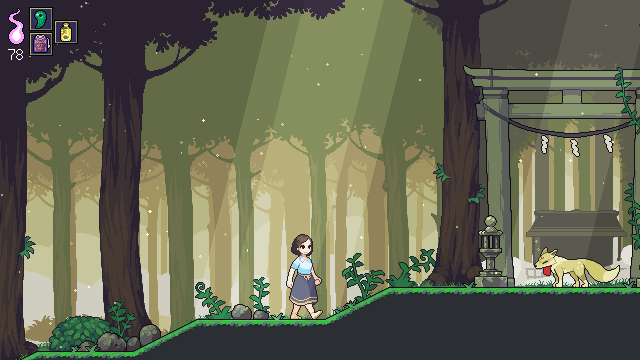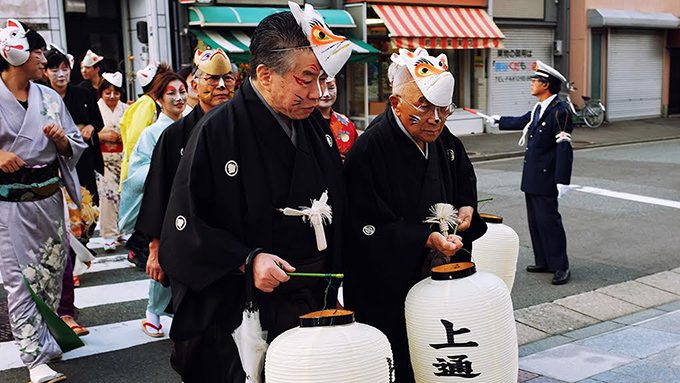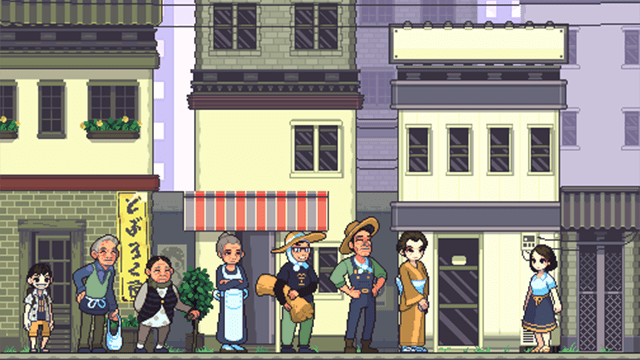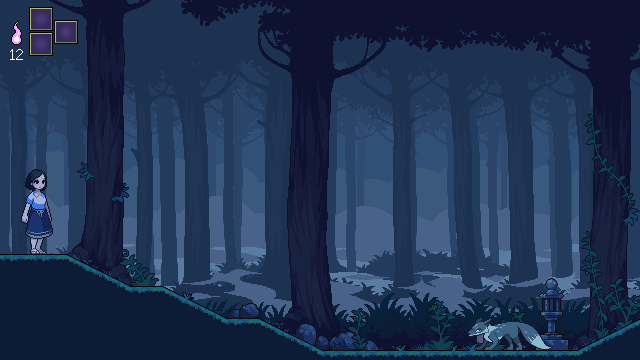While the cliché “love at first sight” was originally coined in reference to people, I feel it is possible to fall in love with other things at first sight as well. One such example, for me, was the recently announced indie-developed video game Miyamori. Everything from the gorgeous character art to the slick 32-bit pixel aesthetic to the captivating story combined together into a swirl of wonder I couldn’t help but fall in love with. In case you haven’t visited the game’s website, allow me to briefly summarize what has been revealed so far:
The story of Miyamori takes place in the Tohoku region of Japan and revolves around two main characters; a young girl named Suzume and a fox spirit (or kitsune) named Izuna. Suzume and her younger brother, Toshiki, live in a town just on the edge of an old forest. Deep within the woods, there lies a shrine which is protected by two fox spirits, the playful Izuna and the sullen Gedo. One fateful night, Suzume’s brother is outside catching fireflies when he mysteriously vanishes. Suzume frantically searches for him, eventually stumbling upon the forest shrine. There, she meets the equally frantic Izuna who is also distraught over the sudden disappearance of her partner, Gedo. The two girls decide to join forces in fear that the disappearances of their loved ones may be connected. Their journey won’t be without peril as Gedo’s disappearance has weakened the forest shrine’s power, allowing vengeful spirits to sneak into the mortal world. Suzume will need to rely on Izuna’s powers to protect her in the forest, but Izuna will need Suzume’s support when traversing the nearby town. Clearly, the fates of these two individuals are now fantastically intertwined.
Recently, I was granted an opportunity to chat with the game’s lead developer and general Jack-of-all-trades, Joshua Hurd. Below is a transcript of our conversation:
GWW: Could you start by telling us a bit about yourself and the team working on Miyamori?
Josh: Sure! I’m Josh, the lead developer for Miyamori; I’m also in charge of writing, soundtrack and audio design, level design – basically anything that isn’t art related. I got my first taste of game development as a teenager making Zelda fan games. I got back into game dev in the past year or so partly because I was spending a lot of time doing front-end web dev and wanted to branch out a bit, and partly because the idea for Miyamori had been floating around in my head for a while and I wanted to see what I could make of it.
Then there’s the wonderful and talented Lachlan Cartland, who’s responsible for the art direction and pixel art. I can be really picky about details sometimes, but I think we both share a similar aesthetic and vision for the game so it’s been great working together.
Also, Kevin Hong has done some fantastic illustrations for the game!
GWW: I know that you actually spent some time in the Tohoku region of Honshu, Japan. That clearly influenced the setting of the game, but what was it about your time there that really inspired this decision?
Josh: Right, so in my third year of university I decided to do an exchange program in Japan, at Akita International University. I took a course on folk culture that involved some field studies, so they had us going out into the community and learning first-hand about different aspects of the local culture. My Japanese is so-so, and I’m introverted by nature, so it was pretty intimidating at first. I remember asking someone about a temple way out in the countryside and not understanding a word through their thick Tohoku dialect. It definitely pushed me outside of my comfort zone, but I’m glad I took it; in general, once people saw your interest was genuine, they really opened up and did their best to share what they knew with you.
As part of the course, I spent a few months studying a fox festival in Akita city, the Shoufuku Kitsune no Gyouretsu Matsuri, which translates to something like “Shoufuku Fox Parade”. The festival was established a little over a decade ago to revitalize commerce in one of the city’s shopping districts; everybody came together to make it possible, and it opened my eyes to the continued relevance of folk culture as a means of self-expression and community building. This idea, along with the theme of foxes as divine messengers formed the core of Miyamori.
GWW: The use of Japanese folklore in video games, especially Japanese spirits (or yokai), has become more prevalent in recent years with video game series like Touhou Project, Shiren the Wanderer and Yo-Kai Watch. Did this affect your decision to revolve the game around these concepts?
Josh: Actually, I feel like there haven’t been enough games with those themes; at least not in the west, because they can be hard to localize well. So part of that decision stems from wanting to add to that body of games, while introducing some of the more obscure, regional yokai and folktales to a wider audience.
I’ve always been fascinated by folk tales for their magical narrative qualities, but lately I find myself a lot more interested in the social dynamics and historical contexts that gave rise to certain beliefs or tales. I think the biggest factor in deciding to base Miyamori around yokai and kami was actually the human and social aspect. There’s a book by Karen Smyers called “The Fox and the Jewel” that does a great job of shedding light on the social context of Inari worship in Shinto, as well as the folk beliefs and festivals related to foxes in Japan. If you’re at all interested in the topic, I’d highly recommend giving it a read.
GWW: You have mentioned that you drew inspiration from games like Okami, Majora’s Mask and Yoshi’s Island. Can you elaborate on how these games have helped to shape the type of game that Miyamori is?
Josh: Okami was a huge inspiration in terms of having fantastic art direction and how it presented classical Japanese mythology and Shinto themes in a refreshing, modern way. As for Majora’s Mask, the whole countdown thing turned some people off, but I loved the way it made everything feel so vital, both in the sense that it added a certain urgency to your actions, and how it made the world come to life. You’d start to learn things about people’s daily lives and their personal struggles; the midnight rendezvous with Anju after she decides to open up to you about her fiancé’s disappearance comes to mind. Your options could drastically change from one day to the next, and people would go about their lives with or without you.
I’m trying to capture some of that feeling in Miyamori, but in a more accessible, less stressful way. This led to creating a world that moves in time to the ebb and flow of people’s daily lives. It also takes stories and characters that might normally be presented as side-quests to the main storyline and places them at the forefront; the game is all about forming bonds and getting to know your community.
Finally, I mention Yoshi’s Island because it was influential in shaping the game feel and platforming elements of Izuna’s segments. It’s such a joy to play; everything feels very fluid and the level design is just excellent.
GWW: From screenshots, it is easy to see that this game is a side-scrolling 2D platformer. However, the mentions of Izuna’s shape-shifting abilities and Suzume’s need to interact with the people who live in her town hint at some possible puzzle and/or RPG elements as well. Is it safe to assume this game is a bit of a blending of different game genres?
Josh: Yes, Miyamori will definitely be something of a genre mashup. I’ll be keeping the details of that hush-hush for a little while longer, but I’d be happy to talk about those gameplay elements at a high level.
The game alternates between you exploring the town as Suzume, and cleansing the land of impurities as Izuna. Suzume’s gameplay leans heavily towards a Phoenix Wright, visual novel style of exploration and investigation, whereas Izuna’s sections involve more typical, action-based platforming. That’s not to say the two styles of play occur in isolation, though… in fact, your actions in one will have immediate consequences for the other. That’s all I can say for now 😉
For the foxes, Izuna and Gedo, I’ve tried to balance their Shinto and folklore representations as divine messengers and trickster figures. With Suzume’s help, Izuna will be able to hone her skills of transformation to harness the powers of various yokai. These abilities will be important for dealing with certain enemies and puzzles in the platforming sections, but Izuna’s transformations also open up a lot of funny possibilities for messing with people in the overworld.
GWW: It seems like the player will be switching between characters, locations and times of day quite frequently. Can you speak a bit on how the gameplay may change in these different scenarios?
Josh: Definitely, all of those elements are geared towards creating a small, living world that provides variety through its depth of experiences. The world of Miyamori can be divided into roughly three areas: the forest, countryside, and city. You can also layer the four main times of day – dawn, day, dusk, and night – on top of these locations, to create a variety of scenarios. Add in the individual schedules of different characters, and the possibilities expand even further.
As an example, there might be a character who owns a vegetable shop on the outskirts of town. Every day, he’s there from 6am to 6pm, selling produce. After closing up shop, he has a quick dinner with his family, then spends the rest of his evening fishing down by the river. Or maybe some nights he goes further into the mountains where the fishing is better. If you talk to him during the day, it’ll be all business, but if you catch him in his spare time, maybe he’ll share a tale or two. In this way, different doors will open depending on time and place.
GWW: I know the game is still in the early stages of development, but what would you say has been your biggest challenge thus far?
Josh: More than anything, my biggest struggle has been finding a healthy balance between work, game dev, and my personal life. I’m working full time right now, so often my only chance to focus on the game is after I get home and on weekends.
GWW: On the flip side, what would you say has been the best or most fun aspect of the development process to date?
Josh: I love the moment when I get to replace placeholder art with the polished pixel art pieces and see the scene come to life. It’s always nice when an idea finally falls into place and just “feels right” – even if it takes some poking and prodding to get to that point. There’s always that moment of “IT WORKS!!!” and then you just play around with it for a while.
GWW: I originally heard about this game from the developer of the successfully funded indie RPG Ikenfell, Chevy Ray Johnston. Could we potentially see a Miyamori Kickstarter campaign down the line or do you have enough private capital to bring the game to release without the need for crowdfunding?
Josh: Oh, I’m really looking forward to Ikenfell! It looks like it’s going to be a lot of fun. Turn-based RPG? Witches and Wizards? Cat-scene cutscenes? Yes, please.
As for a Miyamori Kickstarter… there’s a little more work to do before I’m comfortable putting it out there, but yes, a Kickstarter campaign is definitely in the works for later this year! More details on that to come, though. 😉
GWW: Thank you again taking the time to speak with me about Miyamori. This game has truly captured my imagination. Do you have any parting words you would like to share with our readers?
Josh: It was my pleasure! I’ll just wrap things up by saying that if you want to follow our progress on Miyamori, I post gifs, screenshots, and other mini-updates on Twitter, and there’s also a monthly newsletter where I talk more about the development process and share some of the things that inspired me to make Miyamori. Thanks!
I hope this conversation with Joshua Hurd has gotten you even more excited for the release of Miyamori. You can be sure that I will let you know when the Kickstarter campaign goes live, but if you would like to stay up to date on all things Miyamori until then, be sure to follow Joshua on Twitter and sign up for the monthly newsletter on the game’s website. The game is currently being planned for release in Q3 2017. At launch, the game will be available for PC with a Mac version set to be released shortly thereafter.





